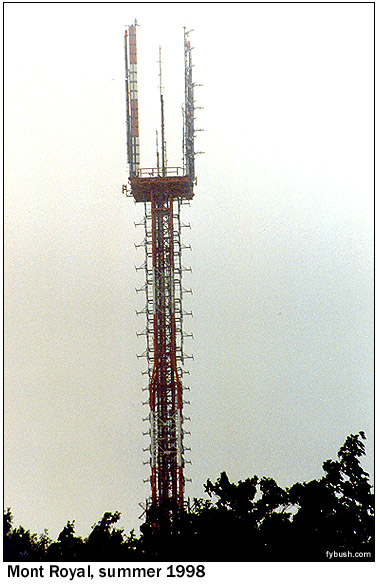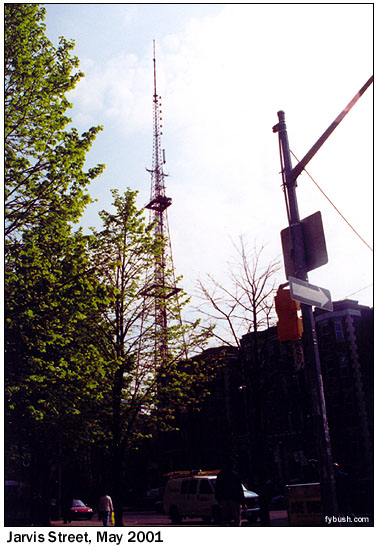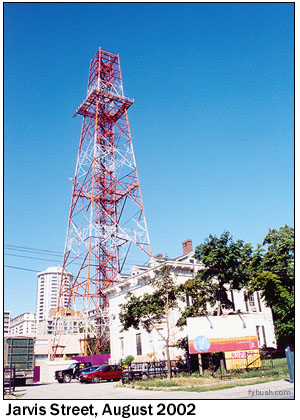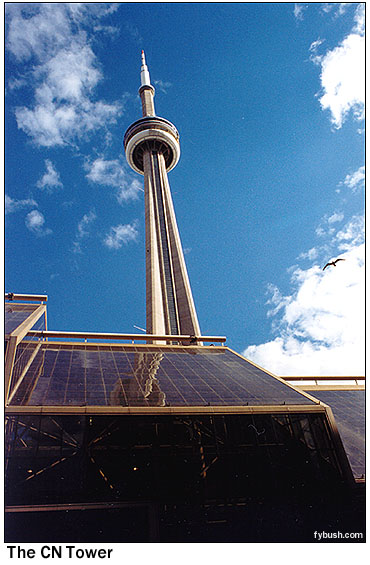
|
|
September 5-11, 2002
Fifty Years of CBC Television Transmitters
 It's been precisely
half a century since the Canadian Broadcasting Corporation flipped
the switch and inaugurated Canada's first domestic television
broadcasting service.
It's been precisely
half a century since the Canadian Broadcasting Corporation flipped
the switch and inaugurated Canada's first domestic television
broadcasting service.
Of course, there was TV in Canada long before CBFT, channel 2 in Montreal, took to the airwaves on September 6, 1952 - but it required a good antenna aimed across the border. And for viewers beyond areas like Toronto, London, Windsor and Vancouver that had easy access to cross-border signals from places like Buffalo, Cleveland, Detroit and Seattle (all of which had TV beginning in 1948), television had to await the start of Canadian transmissions.
It started at 4 PM that Sunday in September, with the cartoon Aladdin and his Lamp as the first program, followed by a cartoon in English, a film in French and a news report. And as best I can determine, it began from the very same spot where CBFT broadcasts today: Mont Royal, some 770 feet above the city and just a few miles north of downtown Montreal, at the peak of the 1870s park designed by Frederick Law Olmsted.
I don't know whether the tower you see here is the same one from which CBFT began fifty years ago; in any event, channel 2 now has quite a bit of company up here!
CBFT was joined two years later by CBMT on channel 6, which allowed channel 2 to go French full-time while CBMT served the Anglophone population. Two more commercial stations made their debuts within the decade: CFTM in French on channel 10, the eventual flagship of the TVA network, and CFCF-TV in English on channel 12, part of the CTV chain.
The 1970s saw the arrival of "public television," as it were, when Radio-Quebec (now Tele-Quebec) began broadcasting here on CIVM, channel 17. Finishing out the collection of TVs on this stick were French-language commercial station CFJP, channel 35 (flagship of the TQS network) in the eighties and Global TV's CKMI (Channel 46) in the nineties. And as you can easily see, Mont Royal is home to many FM stations as well, including CBME (88.5), CFQR (92.5), CBM-FM (93.5), CKMF (94.3), CBF (95.1), CJFM (95.9), CHOM (97.7), CKOO (98.5), CJPX (99.5), CBFX (100.7), CFGL (105.7) and CITE (107.3). It's a lot of RF up there!


Two days after Montreal's CBFT began broadcasting, it was Toronto's turn to become a television city. In the absence of any suitable hills in the city to serve as a transmission site, the CBC built a new tower in the heart of downtown, just behind the Jarvis Street mansion that would serve as the network's Toronto executive offices and next door to the former school building that would be the first TV studios in Toronto.
Dubbed "Eiffel on Jarvis" for its skeletal appearance, the tower was the tallest structure in Toronto when CBLT made its debut on channel 9 on September 8, 1952. It was not an auspicious debut: CBC historian Knowlton Nash recounts the story of how a nervous technician removed the opening slide just before air to make sure it was free of dust, then replaced it - only to be greeted by CBLT's first image: an upside-down, backwards "C B L T" identification!
Programming soon got down to normal, with a news report about an escaped bank robber (anchored by Lorne Greene) and the official station opening at 8 PM. For the next eight years, CBLT would be Toronto's only TV station, though viewers had easy access to Buffalo's stations and to channel 11, CHCH in Hamilton, which signed on in 1954. In 1960, CBLT moved down the dial to channel 6, enabling CTV's CFTO to sign on on channel 9 from a tower at its studio site northeast of the city. (CBLT would move once more, in 1972, landing on channel 5 and clearing the way for Global Television to use channel 6 for its debut soon after.)
The Jarvis Street tower slowly filled up with new antennas: CBC-FM made its debut in the early sixties on 99.1, later moving to 94.1 as CBL-FM, and French television came to Toronto in 1976 with the debut of CBLFT on channel 25. The Ontario Educational Telecommunications Authority, later known as "TVOntario," made its start from the Jarvis Street tower in the early seventies when CICA, channel 19, took to the air; it was soon joined by Ryerson University's CJRT-FM on 91.1.
 By the seventies,
though, the Eiffel on Jarvis was dwarfed by the new skyscrapers
rising to the west and south as downtown Toronto grew into a
major metropolis. The signals from the Jarvis Street tower and
from the more distant transmitters of CFTO and other FM stations
were being swallowed by multipath, and the pressure was on to
build a new master transmitter site.
By the seventies,
though, the Eiffel on Jarvis was dwarfed by the new skyscrapers
rising to the west and south as downtown Toronto grew into a
major metropolis. The signals from the Jarvis Street tower and
from the more distant transmitters of CFTO and other FM stations
were being swallowed by multipath, and the pressure was on to
build a new master transmitter site.
Construction began in 1973 over the railyards west of downtown near Lake Ontario, and after 40 months of work, the CN Tower rose 1815 feet, five inches over Toronto, proudly claiming the title of tallest free-standing structure in the world.
At the thousand-foot level, a pressurized "donut" conceals the many studio-transmitter link antennas and ENG receivers. Above it are the observation decks and restaurants that were added to the design after planners realized the tower would also be a major tourist attraction. And above that, radomes conceal the master TV and FM antennas that are home to CBLT, CFTO, CICA, CBLFT, CFMT (Channel 47), CITY-TV (originally on channel 79, later moving to channel 57), CJBC-FM (90.3), CJRT, CBL-FM, CJEZ (97.3), CHFI (98.1), CKFM (99.9), CHIN-FM (100.7), CFNY (102.1), CHUM-FM (104.5) and CILQ (107.1).
In 2000, digital audio broadcasting, using the world standard Eureka-147 system, began from a directional antenna mounted on one leg of the tower.
(The available space on the master FM antenna proved to be insufficient in the nineties; FM stations that have signed on since, including CISS on 92.5 and the CBC's own CBLA on 99.1, have used the city's next-tallest rooftop, First Canadian Place, for lack of space at CN. CJBC-FM on 90.3 plans to move from CN to First Canadian, potentially opening space on the combiner for one major FM station to move to the big stick.)
Once the CN Tower was in place, the CBC began making plans to move its studios from Jarvis Street, where by the late seventies they rambled through several hodge-podge additions to the original school building, not to mention other leased studio and office spaces around Toronto.
The CBC Broadcast Centre, two blocks north of the CN Tower, finally opened in the mid-nineties, leaving Jarvis Street to sit vacant for several years. When I took the photo above in 2001, signs were posted around the buildings announcing the imminent arrival of the "Radio City" condominium project. Demolition of the CBC buildings began a few months later, and by the late summer of 2002 it was the tower's turn. Beginning in July, workers took down the old CBLT, CBLFT, CICA and FM antennas and pulled down the upper parts of the tower by hand.
The photo above at right was taken on August 19. On Saturday, August 24, demolition crews set charges around the base of the remaining tower and brought it down, ending the history of this important site just weeks shy of its big anniversary. "Radio City" should be available for occupancy next year...
Learn more about the CBC's TV history at the official CBC TV 50th site!
- Previous Site of the Week: Plattsburgh, N.Y.
- Next Week: One World Trade Center, New York
- How can you help support Site of the Week? Click here!
- Submit your suggestions for a future Site of the Week!
